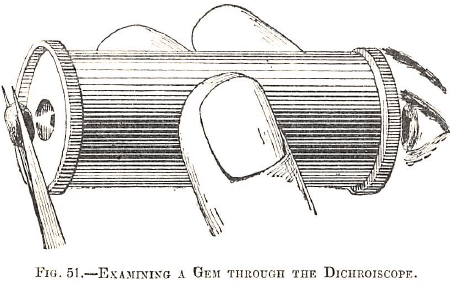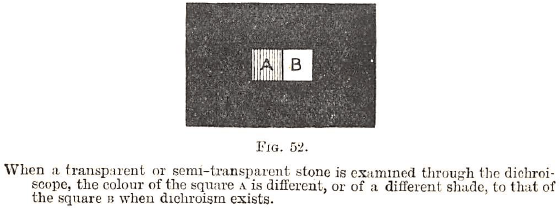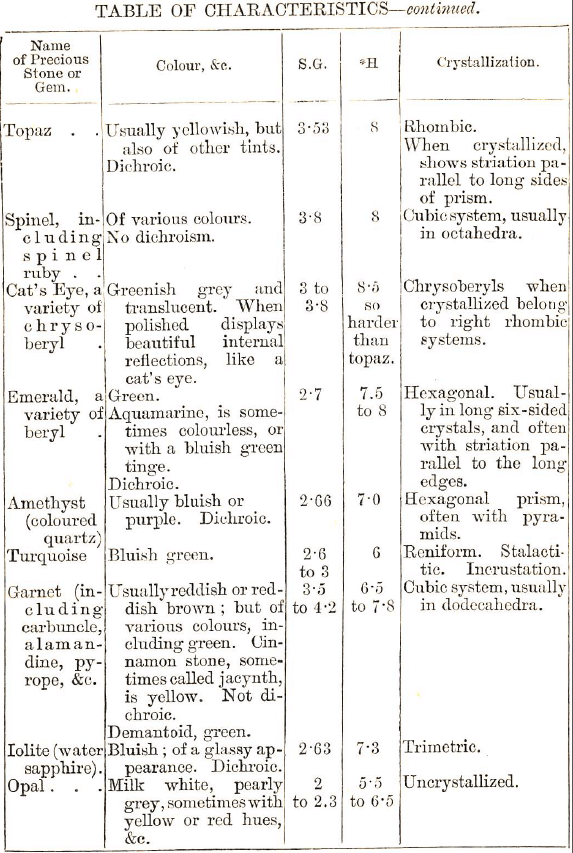Most precious stones belong to such formations as granitic, gneissic, porphyritic rocks, and are generally found in the débris of such; and although certain diamond-bearing soils may be of a comparatively recent age, they are for all that made up of the constituents of the older rocks.
Corundum, sapphire, and ruby are found in gneiss, granite, mica slate, chlorite slate, dolomite, or granular limestone.
In Ceylon precious stones are searched for in the beds of rivers, also in a gravel deposit (generally ten or twenty feet below the surface). This deposit, called Nellan, consists of waterworn pebbles, together with pieces of granite, gneiss. The gems occur in “pockets ” and in groups. Rubies are also found in dolomite.
The Burmah rubies are found in a limestone deposit; also in alluvial deposits (formed from disintegrated gneiss rock), in beds of rivers, in limestone rock.
Veins through mica-schist and clay-slate, black limestone, cavities in granite have yielded emeralds : from porphyritic rocks precious opal has been obtained, also from sandstone ; also in a brown iron ore in Queensland.
Emeralds are found in various metamorphic rocks : clay slates, associated with calc spar.
The turquoise of Persia is obtained from porphyritic trachyte : that of Silesia and Saxony from clay-slate: that of New Mexico in quartzite, sandstone, &c. In Arizona and Nevada, too, turquoises are found in clay slate.
Topazes are met with in talcose rocks, gneiss, granite.
Diamonds are usually met with in alluvial soil, often on gold-diggings. In some Indian fields there is a diamond- bearing conglomerate made up of rounded stones cemented together, which lies under two layers, the top one of gravel, sand, and loam, the bottom of thick black clay and mud. Also found in flexible sandstone in America, India. In N.W. of West Australia in a gold-bearing conglomerate.
In Brazil the most precious of all gems is obtained from a conglomerate of white quartz, pebbles, and light coloured sand, sometimes with yellow and blue quartz and iron sand.
In South Africa the diamondiferous alluvial deposits consists chiefly of nodules of granite, basalt, sandstone, and in it are garnets, jasper, agates, pebbles (streaked with a succession of parallel rings) whose specific gravity is the same as that of the diamond: so, too, in East Indies, &c. Diamonds are often associated in river diggings with topaz, garnet, zircon, spinel ruby, native gold, tinstone.
At the Kimberley mine, which, more or less, representa others in the neighbourhood, the diamondiferous ground forms a ” pipe ” or ” chimney,” surrounded by formations totally different to the payable rock. The encasing material is made up of red sandy soil on the surface, underneath which is a layer of calcareous tufa, then yellow shale, then black shale, and below this, hard igneous rock. The diamond-bearing ground consists of “yellow ground” (really the decomposed “blue ground”), which is comparatively

friable; and, deeper down, the “ blue ground ” (hydrous magnesian conglomerate), which needs blasting by dynamite. The “ blue ground ” is of a dark bluish to a greenish grey colour, and has a more or less greasy feel. With it are mixed portions of boulders of various kinds of rocks, such as serpentine, quartzite, mica-schist, chlorite-schist, gneiss, granite, &c. All this “ blue ground ” has evidently been subjected to heat. The gems are in the matter which binds together these rocks, not in the rocks themselves. A diamond-bearing “ blue earth ” formation occurs at Wajra Karur, India. Diamonds are also found in Russia, America, various parts of Australia, New Zealand, Borneo, &c. The method of detecting the diamonds is the same in principle everywhere. The big stones are thrown aside, and the smaller matter is washed and examined for diamonds.
Diamonds, spinel ruby, or garnet are never found as six-sided prísms, and thus several commoner crystals can be distinguished from them ; nor are emeralds, sapphire, zircon found as cubes, octahedrons, or rhombic dodecahedrons. With the exception of diamond (which is pure carbon), precious

stones may be divided into two classes—those which have alumina as the base, and those which have silica. Of the first are the sapphire, ruby, emerald, &c. ; of the second are the amethyst, opal, cat’s-eye, agates.
To estimate the value of an uncut diamond there is no fixed rule, on account of the fluctuation of prices.
The hardness and lustre are the most reliable tests to detect this choicest of all gems. A diamond will scratch any mineral; but in testing it care has to be taken that the angles be not broken, as, notwithstanding hardness, it is rather brittle.
Topaz may sometimes be distinguished from similarly looking stones by its perfect cleavage; also when crystallized, by its striation being parallel to the long edges, whereas in rock crystal it is at right angles to them.
Beryl, aquamarine (light bluish or greenish), and emerald differ only in the colouring matter. Their cleavage is imperfect. The blue sapphire, oriental ruby, oriental amethyst, oriental emerald are pure alumina coloured by metallic oxides. Rock crystal is pure clear quartz. Amethyst (violet or purple), smoky quartz, cairngorm, rose quartz are transparent silica variously tinted—to which is due the peculiarity of its reflections.
In a mica-schist country garnets—opaque, translucent, or transparent—are sometimes very plentiful, and, if the waterholes and parts of the rocky stream beds, such as those under rocky ledges, be examined, they may frequently be gathered, even by the handful, and often quite collected together and apart from sand, &c. So, too, at the junction of a stream and a lake, small pinkish or brown patches of the little ones may be noticed at some little distance off. Though garnets, unless some of the larger and nicely- coloured ones, are of little or no value, their presence in the above places may be useful to the prospector, who certainly should examine the collections or patches for more valuable minerals, such as diamonds and other precious stones, as well as for minerals of greater specific gravity than that of the main constituents of the country rock, although the specific gravity of the garnet is only 3—4. Waterworn garnets are frequently nearly globular.
In the accompanying table certain peculiarities of precious stones, such as hardness and specific gravity, may be useful to the prospector; at the same time, especially when there is no apparent crystallization in a specimen to distinguish a certain precious stone from one which may be similar in appearance, yet, perhaps, of much less value, or, perhaps, more, is not always an easy matter, even though hardness may be a guiding test. To assist any one in doubt, and in many instances to settle the point, the dichroscope (in shape a cylinder 2 inches long and 1 inch in diameter, and so easily carried about) is most useful, taking for granted that some practice with the various kinds of translucent or transparent stones of various shades and colours has been acquired, A preliminary examination of a few sapphires and rubies, spinel rubies, garnets, topazes, tourmalines (green, brown, red), zircons of various colours, andalusite, water sapphire, coloured quartz (including amethyst), &c., will impart a confidence very much more than any tabulated results of dichroism, which depends much on the intensity or depth of colour in the stone.
Placing (by means of a tweezers) a translucent or transparent stone close to the one end of the instrument where the two square images are seen when the instrument, held skywards, is looked into, and turning it about in various directions, and at the same time turning the instrument round, the observer will notice whether the colour of the two squares is one and the same. If the stone is amorphous, such as glass, flint, obsidian, &c., or crystallizing according to the cubic system, such as diamond, spinel ruby, garnet, &c., the two squares will be of the same colour. In other cases the colour of one square will be of a different colour to that of the other when the coloured stone is examined in certain directions, though it may be the same in certain others.
Thus a true ruby, which affords two shades of pink, can be distinguished from a spinel ruby or garnet without dichroism, or from a pink tourmaline (rubellite), which gives two colours, but somewhat differently to those of ruby; so, too, a sapphire, which gives a blue shade in one square and a light shade of colour without any shade of blue in the other (though sometimes in a deeply-coloured stone what might be considered as a greenish blue is noticed), can be distinguished from an amethyst, which affords two shades of purple, or from a blue spinel (which does not show any twin coloration), or from an iolite (or water sapphire), in which the coloration is of its own kind.
A tourmaline (very frequently associated with other gems, especially in Ceylon), either the green or brown, can be recognised directly (indeed, often without using the dichroscope) by the colour of the one square being quite dark compared to that of the other.
An emerald affords two distinct shades of green (one bluish) easily remembered (quite distinguishable from the dichroism of a green tourmaline); so a green garnet, which does not show twin coloration, cannot be mistaken for it.
With the dichroscope and two or three minerals, such as the sapphire, topaz, and rock crystal, to test for hardness, and a little practice—the more the better—and a slight knowledge of the crystallization of minerals, which, though frequently found water-worn, not uncommonly retain traces of the original crystal edges and faces, the prospector can examine his specimens with a very much easier mind than he would do without them.
Frequently neither the hardness of a gem stone nor its behaviour before the dichroscope is sufficient to enable its identity to be reliably known. In such a case its specific gravity may settle the question ; but it must be confessed this requires a more accurate balance than the prospector may possess, and the advice of an expert may be necessary.
Of all the different transparent or translucent minerals there are only a few kinds of value, and so a knowledge of the dichroism of all these in different colours and different depths of colour should be acquired.


Tourmaline (of various colours). H.—7·5. Very dichroic.
Peridot is a yellowish-green variety of olivine. Chrysolite, a yellow or greenish-yellow variety, is softer than quartz.
Zircon (including hyacinth and jargoon) is of various colours. S.G-., 4·7, and thus the heaviest of precious stones. H.—7·5. Crystallization, tetragonal.
Moonstone, sunstone (with infernal reflections), and adularia are varieties of felspar.
Lapis-lazuli is a nearly opaque, blue stone. (H.—5·2.)
Smoky quartz, cairngorm, false topaz, milky quartz, yellow or citron quartz, rose quartz, rock crystals, Bristol and Gibraltar diamonds, are varieties of quartz; so too are crocidolite, onyx, sardonyx, sard, bloodstone, jasper, agate, moss agate, or mocha stone. chrysoprase (of an apple-green colour), plasma (green), chalcedony, cornelian, avanturine (usually brownish or greenish, speckled with mica), heliotrope (spotted), firestone and quartz cat’s eye, potato-stone, &c.
The crystallized varieties are usually of the form of hexagonal prisms capped by pyramids, and have approximately S.G.—2·65 H.—7.
Jade (generally slightly translucent and greenish, greenish white, milky white, &c., includes N.Z. greenstone. H.—6·5 to 7.
Alexandrite and oriental chrysolite are varieties of chrysoberyl.
There are many of the gems of comparatively little value that are in reality not always profitable for a person to pay much attention to the discovery of; that is, of course, unless the quantity of them is great, for the cost of polishing the same is an important factor in assigning a value to them. Many coloured transparent and translucent kinds of quartz, coloured by metallic oxides, fall under this category. But so easy is it to prospect a stream, say in a country of crystalline, plutonic, or metamorphic rocks, that a search for precious stones and gems of all kinds should be made much more than is usually the case. With regard to the precious varieties, it is well to bear in mind— for instance, when dealing with a heap of Ceylon gem stones—that the valuable specimens may be associated with all sorts of worthless specimens, all of which, though impure in quality, may really be sapphires, spinels, chrysoberyls, tourmalines, zircons, &c.
Though many are translucent rather than transparent, many dark in outward appearance, and all water-worn, more or less, and with surfaces not at all glass-like, and the majority not apparently transparent or translucent unless held up to the light, yet, here and there a good specimen may be found. For all that, a knowledge of the general appearance of such impure specimens is probably of as much importance as that of the good ones; for the prospector who comes across them has an encouragement in his search for valuable ones.
For some reason or other, diamonds and gold are often found in the same alluvial deposit, and so auriferous beds should be examined for the precious stone. The specific gravity of the diamond—higher than that of quartz or most pebbles—and that of gold are so very different, that it does not follow that, for instance in a stream bed, these two minerals are always found close together.
On page 89 it has been mentioned that diamonds are sometimes found in flexible sandstone; but if they are not discovered in a particular deposit of this sandstone, the presence of this formation in a district is a very good one for the prospector to know of, as the diamonds may still he found not very far off.
